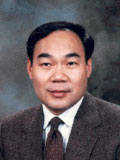Wesley Chu

Wesley Chu made multiple contributions to the field of computer science, but his research and development of statistical multiplexing is the reason for including him in this history. In 1967, after earning his PhD in Electrical Engineering from Stanford, he went to work at Bell Labs (AT&T), where he joined a group studying the technical issues of transmitting data over phone lines. The group discovered that terminals typically transmitted only 5% of the time that they were connected, leaving the lines idle for the remaining 95%. Given the high cost of communications at the time, because carriers charged a minimum fee for each connection, and the nature of computer communication was short bursts of data, the group focused their research on ways to transmit more data within a given connection.
When Chu joined the faculty at UCLA in 1969, he continued his work on data transmission, investigating the concept of asynchronous time division multiplexing, which he later termed ‘statistical multiplexing’. This evolution of multiplexing solved the problem of what to do when connected terminals had no data to transmit, allowing terminals that did have data to transmit to take precedence. This type of control required significant processing power and memory. While Chu explored using early microprocessors to achieve this control, the development of Intel’s 8008 8-bit microprocessor in 1972 gave Chu the affordable processing power he needed to build a 64-terminal prototype. Chu filed for successful patents in ’76 and ’77 for his designs.
In this interview, Chu describes his work at Bell Labs and UCLA as he developed his statistical multiplexer and its impact on the Data Communication industry. Ironically, as he was first building models to solve this problem, his colleagues working down the hall in Leonard Kleinrock’s lab were connecting the first Arpanet IMP and measuring data traffic to understand data flow on the subnet.
When a number of engineers and entrepreneurs mentioned Chu’s name, and that he was doing research on multiplexing at UCLA, I soon found him and arranged for this interview. Chu was a very soft-spoken, individual, full of curiosity and enjoyable to talk to. Although his work did influence the developments of multiplexers in the industry, his influence was modest: it was an idea who’s time had come, and other engineers had similar ideas, developing their own versions of statistical multiplexers. It was an example of cutting edge academic research that could have been financially rewarding for a university. The opportunity for royalties was never pursued by Chu or UCLA, and perhaps their claims may not have born much fruit.
Keywords: Statistical Multiplexing, Bell Labs, UCLA